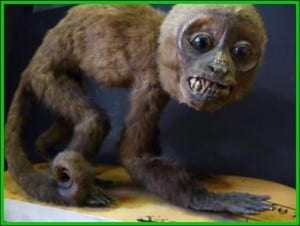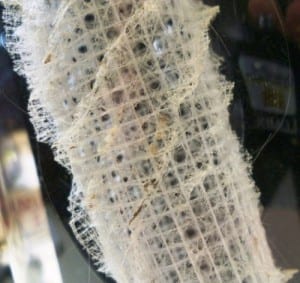From the Archives: A Camel Head from London Zoo
By Mark Carnall, on 8 October 2014
Here at the Grant Museum, we have a large collection of documents, photographs, negatives and other ephemera which make up the archive of the collection. Part of my ongoing role as the curator of the Grant Museum is to ensure that all of this archival information is attached to the relevant museum specimens so we have as much as a history of possible of the lives and after lives of our specimens. This marks the first post in what will be occasional series highlighting interesting finds about the museum and the specimens from the archive.
This first post contains some rather grim imagery so the images are after the jump but whilst rifling through the archives I found images of a bactrian camel head which had been sent to UCL from London Zoo. POTENTIALLY DISTURBING IMAGES HERE ON IN.
Specimen of the Week: Week 156 (The Evolution of Life on Land)
By Jack Ashby, on 6 October 2014
 It’s the third birthday of the Specimen of the Week blogs, so this one is a special one, tackling one of the biggest events in global history (no exaggeration). It’s also the start of winter term at UCL, and that means that Grant Museum returns to doing the very thing our collections were first put together for – spending the day teaching students about life.
It’s the third birthday of the Specimen of the Week blogs, so this one is a special one, tackling one of the biggest events in global history (no exaggeration). It’s also the start of winter term at UCL, and that means that Grant Museum returns to doing the very thing our collections were first put together for – spending the day teaching students about life.
This term every week we have a palaeobiology class where the students learn about vertebrate life from the beginning – looking at each group in turn as they evolve in the fossil record. That has inspired my choice of specimen this week.
As an Australian mammal nerd, it’s often tempting to think that nothing interesting happened between the appearance of multi-cellular life a little over 500 million years ago, and 200 million years ago when the first platypus-ish things appeared*. However, sometimes it’s important to think about where it all began: the fishy animals without which there would be no you, no me, no internet cats, and no platypuses.
This week’s specimen of the week is… Read the rest of this entry »
Dragons of Arabia
By Edmund Connolly, on 2 October 2014
Yours truly recently trotted off to the British Museum to see the new Ming Exhibition the other day. Given the varied reviews of Vikings, I was glad to see a new exhibition which was back on top form.
Boxing Clever
By Dean W Veall, on 2 October 2014
Dean Veall here. In my role as Learning Officer I am responsible for our exciting adult events programme, and I thought I would share our next event coming up this term, it’s the return of the brilliant Focus on the Positive. Focus on the Positive is an event developed by UCL’s Public Engagement Unit where UCL’s researchers pitch their ideas for projects to the audience in order to secure their vote with the successful pitch walking away with £2,000 prize money to make it a reality. Here at the Museum we jumped on the opportunity to host a Focus on the Positive back in February and the winners Philipp Boeing and Bethan Wolfenden are back to share with us how their project has been developing.
First day with the sponges
By ucwaemo, on 1 October 2014
Today I begin an artist-in-residency position at the Grant Museum of Zoology, funded by The Leverhulme Trust. I’ll be working with the Museum’s collection of deep-sea sponges, focusing in particular on their calcareous and glass sponges. These extraordinary animals (not plants, as the Museum’s founder Robert Grant discovered back in the nineteenth century) are composed of calcium carbonate and silica – limestone and glass.
I will be spending the next ten months here studying the sponge collection with the aim of creating art from the same materials that the sponges use to build themselves. Read the rest of this entry »
Specimen of the Week: Week 155
By Tannis Davidson, on 29 September 2014
 Hello all. In anticipation of writing my first Specimen of the Week post, I wondered which specimen would ultimately receive the honour. I wanted to highlight a specimen representative of my Canadian homeland such as a fossil from the Burgess Shale, but the curator (see SOTW 140) beat me to it. Sadly, the Grant Museum has but one documented specimen from this phenomenally important fossil location. The Burgess Shale has famously yielded dozens of previously unknown 505 million year old fossil organisms such as the evocatively named Hallucingenia, five eyed Opaginia, and the fearsome-looking predator Anomalocaris.
Hello all. In anticipation of writing my first Specimen of the Week post, I wondered which specimen would ultimately receive the honour. I wanted to highlight a specimen representative of my Canadian homeland such as a fossil from the Burgess Shale, but the curator (see SOTW 140) beat me to it. Sadly, the Grant Museum has but one documented specimen from this phenomenally important fossil location. The Burgess Shale has famously yielded dozens of previously unknown 505 million year old fossil organisms such as the evocatively named Hallucingenia, five eyed Opaginia, and the fearsome-looking predator Anomalocaris.
As it turns out, I was able to find an interesting animal from the collection…one which might possibly be a living relative of Anomalocaris!
This week’s Specimen of the Week is… Read the rest of this entry »
Underwhelming Fossil Fish of the Month: September 2014
By Mark Carnall, on 26 September 2014
Welcome to this month’s underwhelming fossil fish of the month, a monthly romp through the uninspiring and underwhelming fossil fish collections here at the Grant Museum of Zoology (and every natural history museum). Normally this blog is a tongue in cheek reflection on the countless fossils that are ‘important for science’ that lay untouched in museums stores. This month however, I’m reporting on some serious science. Apologies to readers who hate that kind of thing.
Last month a group of top palaeontologists, museum curators and members of the public put their minds together to answer one of the most pressing unanswered questions in science. Where are all the ghosts of animals? There seems to be a disproportionate number of white ladies, hanged criminals and wives of Henry the VIII who cling to this realm but where are the ghosts of all those millions of animals which have lived and died? Why aren’t the prairies teeming with the spectres of dinosaurs? Why isn’t the sea thick with the ectoplasmic apparitions of marine reptiles and fish? Where are the ghostly Carboniferous forests? One reason for this dearth of ghosts may be that it’s mostly humans who have unresolved business or revenge to enact upon the living, other organisms are more pragmatic about the violent nature of life and death. Another untested hypothesis is that you can only see ghosts of your own species.
This is definitely an area ripe for research but there are no research departments in the UK looking at the issue of missing ghost animals. With this in mind I made an astonishing discovery whilst looking for this month’s underwhelming fossil fish my only wish was there was a month normally associated with the paranormal, mythological and spooky when it would be better to announce this discovery failing that here’s September’s Underwhelming Fossil Fish of the Month.
A Medical (School) Mystery
By Nick J Booth, on 24 September 2014
For most of the last two weeks of September I was working on a collections project aimed at auditing, repacking and photographing the UCL Physiology Collection. Although the collection itself consists of only 82 objects (for now), it shares its store room with a large number of additional objects, papers, books and other ‘misc’ material. It was quite a job, and took 5 of us the best part of two weeks to complete.
Among the objects and papers we saw during the work were two 20th century dog respirators, half a door, papers relating to experiments on Everest and lots of framed portraits and photos.
Included in this last lot was a particularly perplexing object, which caused us all to scratch our heads for a while.
Specimen of the Week: Week 154
By Dean W Veall, on 22 September 2014
 Hello new readers, occasional fans and dedicated followers of Specimen of the Week. Dean Veall here. My other specimens here have been all about the underdog, the specimens that do not get much attention because they are of the invertebrate persuasion or are stuffed away in a drawer. But this week I am breaking away from this and going all out popular with a specimen that features heavily in our promotional material and one loved by our visitors, selling out, some might suggest. To those people I say no. No, I am staying true to my beliefs with this week’s specimen. This specimen although popular is very much a minority within our collection it’s just one of only 73 taxidermy specimens we have in a collection of 68,000 and it is one that represents a group that has been terribly misunderstood taxonomically.
Hello new readers, occasional fans and dedicated followers of Specimen of the Week. Dean Veall here. My other specimens here have been all about the underdog, the specimens that do not get much attention because they are of the invertebrate persuasion or are stuffed away in a drawer. But this week I am breaking away from this and going all out popular with a specimen that features heavily in our promotional material and one loved by our visitors, selling out, some might suggest. To those people I say no. No, I am staying true to my beliefs with this week’s specimen. This specimen although popular is very much a minority within our collection it’s just one of only 73 taxidermy specimens we have in a collection of 68,000 and it is one that represents a group that has been terribly misunderstood taxonomically.
This week’s Specimen of the Week is…
Murder in the Theatre
By Edmund Connolly, on 18 September 2014
Greek plays seem to be having resurgence across Britain. The National’s Medea has only just come off and the Old Vic are hosting Electra, both tragedies with a lot of deaths and political commentary.
Given their morbid tone why are they so popular? With modern attention spans dwindling perhaps their short punchy nature appeals over epic 3 hour long Shakespeares. Over in 90 minutes and loads of action, it’s an easy sell to people working late or in need of entertainment.
 Close
Close






